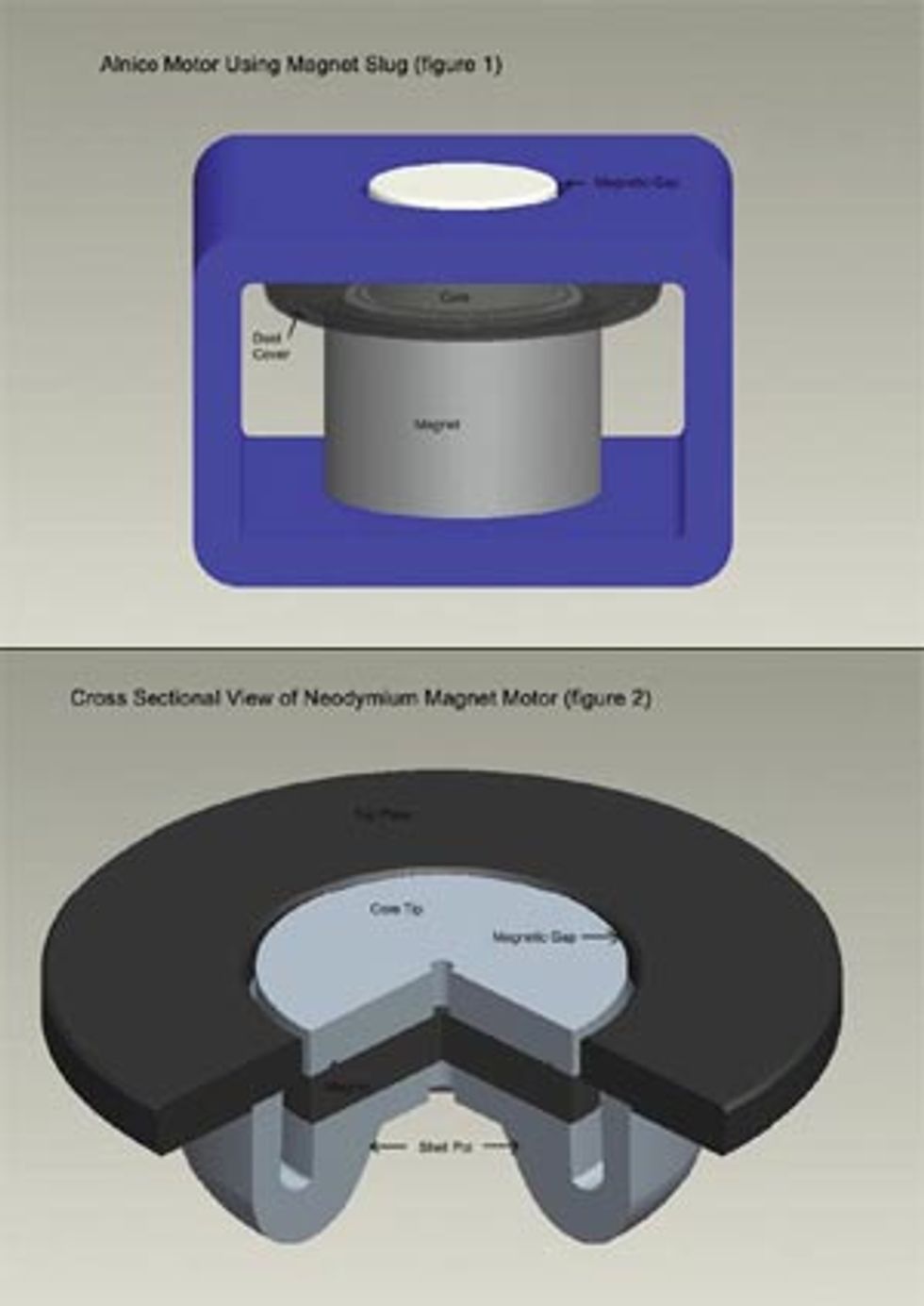This month we’ll continue discussing ceramic, Alnico and neodymium magnetic motors. In the early days of speaker manufacturing, Alnico was the magnet of choice, but increased costs forced manufacturers to seek cheaper alternatives. It was also not as critical to have as tight a magnetic gap on a ceramic motor. This was a big plus because it made manufacturing easier. Alnico has a much lower coercivity; which is easier to demagnetize and it requires a stronger field to keep it magnetized. 
Figure 1 shows another commonly used motor. This is an Alnico slug housed inside a rectangular yoke. The top and bottom of the yoke act as the top plate and back plate. The core, positioned above, is glued to the magnet. Note that the magnet is beneath the voice coil on this design. A dust guard between the core and the top of the yoke is used to keep debris out of the magnetic gap.
Like Alnico, neodymium is also available in different grades. Manufacturers must consider price, strength and operating temperature when selecting the grade of neodymium.
A neodymium motor is shown in figure 2. The neodymium magnet is a slug similar to an Alnico motor. A shell pot houses the motor assembly. In order to achieve higher power ratings, optimal heat dissipation must be achieved when designing the shell pot. The core, also referred to as a core tip, is a slug much like the magnet, and is positioned above the magnet. This design features the magnet inside the voice coil.
The biggest affect of this design is a decrease in inductance (or Le) that lends a brighter speaker, a bit more extended in the top range. This is not intended to imply that all neodymium speakers are inherently bright; it is just brighter in comparison to a similar design with a ceramic magnet. There are plenty of design options with other components one can use to compensate for brightness.
One drawback of neodymium guitar speakers is that there are not a lot of component options available. Neodymium is fairly new and more expensive, and manufacturers must weigh demand versus tooling costs. The toolbox for neodymium designs in regards to cones, voice coil diameters, magnet sizes, etc. remains fairly small right now.
One major point I want to convey is when you compare speakers using different magnetic materials, there are likely several other significant differences that attribute to the overall sound as well. This makes generalizations nearly impossible. In order to make a fair apples to apples comparison, you would have to compare two speakers with the same cone, spider, voice coil, dust cap, etc., but with different magnetic materials having the same flux.
As we’ve discussed and seen, magnet placement can vary from one design to the next. Also, magnets vary in strength from one material to the next. They even vary in size and possibly grade when comparing two of the same material. If you could compare speakers that have the same magnetic flux but are generated from different magnet compositions, you probably wouldn’t notice a difference in tonality. Differences in tonality that are often attributed to the magnet material probably have more to do with the positioning of the magnet and resultant differences in magnetic flux within the motor structure.
In conclusion, prices on Alnico speakers are already a lot higher; due to recent and imminent price increases on the materials used to produce Alnico, especially cobalt, such speakers are expected to increase further in price. If you are convinced that you can only achieve “that sound” from an Alnico speaker, then be prepared to pay dearly for it. You probably should not consider a neodymium speaker unless you are looking for weight savings. You will spend a little more to get it and your options will be a bit limited. Yes, more designs with neo will certainly hit the market, but I don’t think the feeling that more horsepower takes more cubic inches will ever go away. There’s still a pretty good market for tube amps! Ceramic magnet speakers are the most cost effective approach and there are many more tonal options available.
Anthony “Big Tony” Lucas
is a guitarist and Senior Lab Technician at Eminence Speaker LLC, where he specializes in guitar-speaker design and customer support. Big Tony has been with Eminence for over 10 years and is responsible for many well-known guitar speaker designs.









![Rig Rundown: Russian Circles’ Mike Sullivan [2025]](https://www.premierguitar.com/media-library/youtube.jpg?id=62303631&width=1245&height=700&quality=70&coordinates=0%2C0%2C0%2C0)












